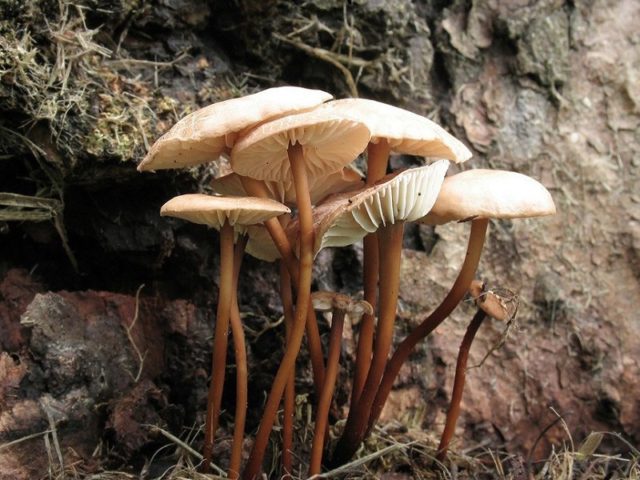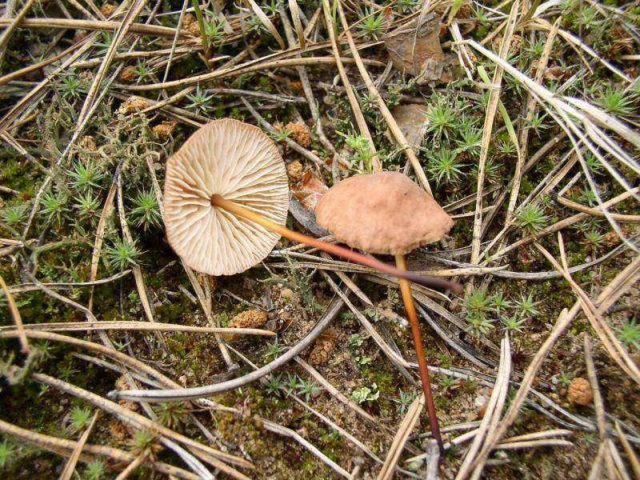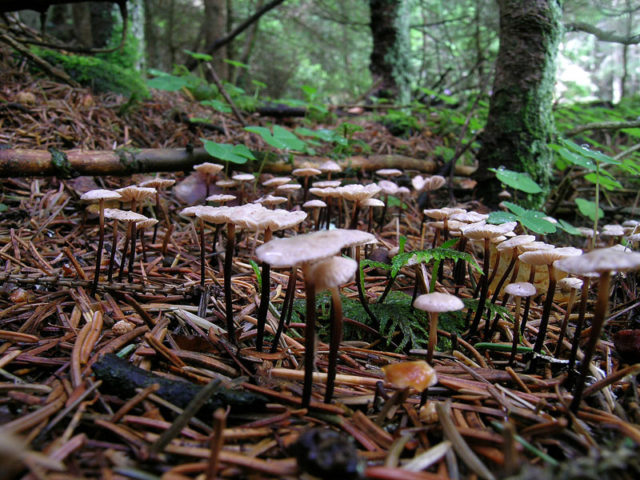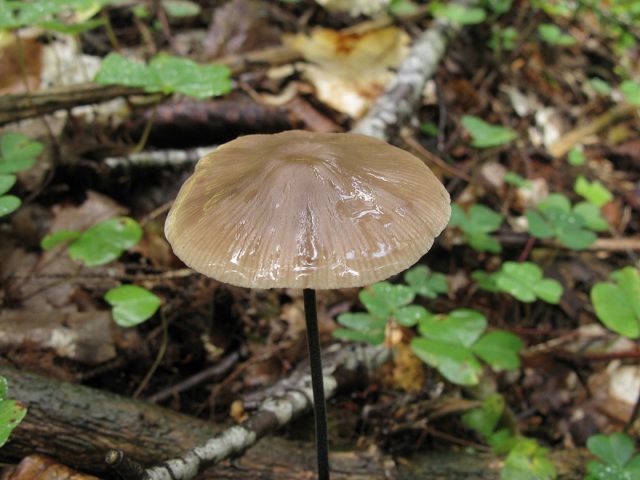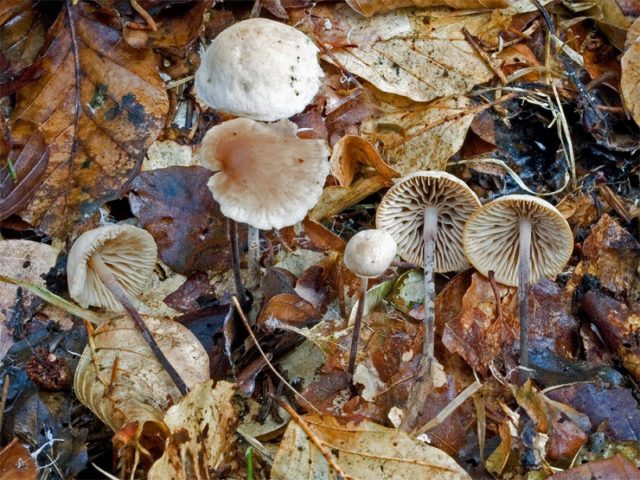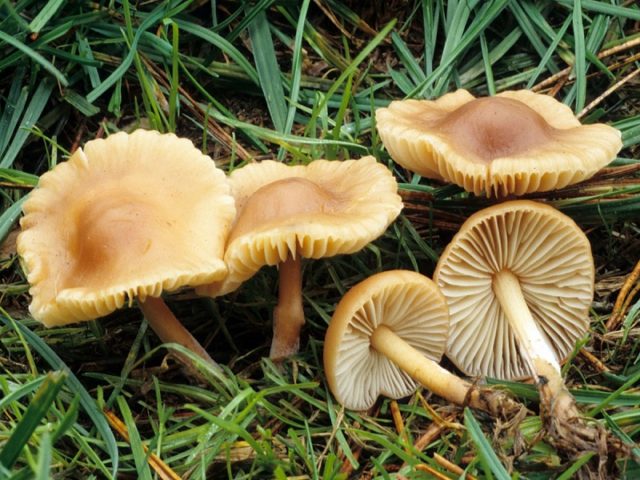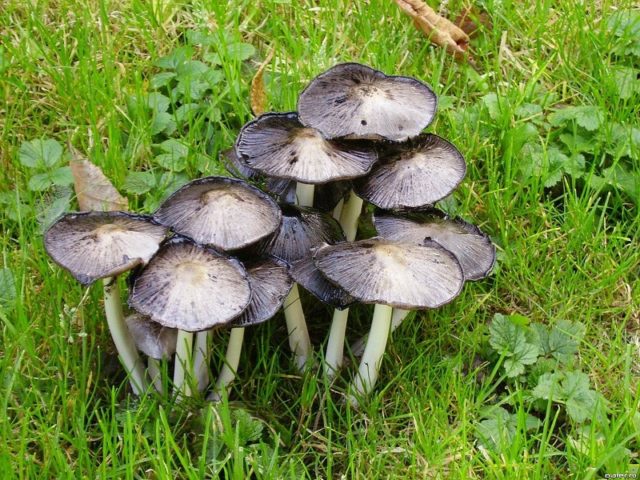Content
In addition to the well-known mushrooms, which are the basis of many dishes, pickles and pickles, there are species that can easily be used as a seasoning for them. The garlic mushroom can play such a role. It has a scent very suitable for the pungent and spicy forge. If you pinch off a piece of the cap and rub it between your fingers, you can smell the obvious garlic smell.
What does a garlic mushroom look like?
As you can see in the photo, the garlic, or common nonnie, is a very small lamellar mushroom with a thin stem.
Mushroom is easily confused with toadstool. It has a small cap that gradually changes in color from ocher to dark brown. Its leg is thin and long. A distinctive feature is the strong garlic smell of the mushroom, which persists even after drying.
Description of the hat
The garlic mushroom has a convex cap, the average size of which is 2 cm in diameter. Over time, it flattens out and becomes more extended. In the beginning - yellowish, with age, the surface gradually darkens and becomes fawn. The miniature cap of the common garlic is dry in consistency, thin, with a rough skin and grooves along the edges. In adulthood, it takes on the shape of a bell with thin fields and a depression in the center.
The plates have different lengths, wavy and convex shapes. Their color is white or pink. The spore powder is whitish.
Leg description
The structure of the leg of the garlic is hollow. Its length, depending on age and place of growth, ranges from 0.5 cm to 5 cm, thickness is about 2 mm. Judging by the photo of the garlic mushroom, the surface of the leg is bare, at the bottom with pubescence, it has small longitudinal grooves. The reddish color at the base brightens somewhat.
The flesh of the leg is pale, with a garlic smell, which becomes stronger after drying.
Is the garlic mushroom edible or not
Common Negnium is an edible mushroom that has long been used for frying, pickling, cooking and drying. After boiling, its spicy taste disappears, and drying it only enhances it. On the basis of the garlic, spicy seasonings are created, which are legendary. One of them says that Napoleon's chef prepared such a mushroom sauce that the guests ate the emperor's old fencing glove with him. It was from there that the saying went that with such a sauce you can eat the sole.
The use of garlic mushroom in cooking
Non-flammable mushrooms are edible mushrooms and do not require pre-boiling. Thanks to the symbiosis of mushroom and garlic aromas, cooks are happy to add them to any dish.Garlic is the base of a spicy sauce, especially appreciated by gourmets. Mushrooms, fried with potatoes, delight them.
In a dried state, garlic plants can be stored for several years. Before cooking, they are thrown into water, and after a few minutes they return to their original appearance, taste and aroma.
Useful properties of garlic
Due to its antiviral and bactericidal properties, the garlic is used as a raw material for the production of prophylactic and therapeutic agents.
In nature, the mushroom is not subject to decay, and this feature is used to extend the shelf life of products.
The discovered antibiotic substances in the garlic plant actively manifest themselves in the destruction of an aerobic bacterium - Staphylococcus aureus.
Where and how it grows
The Nebnichnik can be found in coniferous or deciduous forests. It is widespread throughout the Northern Hemisphere. The favorite basis for its growth is at the base of trees: moss, small litter, foliage, bark. It can also grow on mossy trunks or birch stumps.
Fruiting of the culture is long - from July to October. Sometimes its representatives are called all-season, since they can be found in winter, during the thaw period, on forest thawed patches. The best time to harvest is after rain, since the mushrooms are saturated with moisture, become clearly visible to the eye and at the same time emit a characteristic odor, which makes them easy to find.
Does the garlic mushroom grow in the Moscow region
Among the wide variety of mushrooms growing in the Moscow region, there is also a garlic, which can be found until November in the deciduous forests of central Russia. The places of its growth are in areas with dry clay soils, sandstones. They like to settle in large groups on rotting trees, needles, foliage, bark, branches, and very rarely in the grass.
Is it possible to grow a garlic mushroom on the site
It is not difficult to grow garlic plants on a personal plot. In shady areas of the garden, they feel great. The optimum temperature for development is 15-20⁰С. To get mushrooms you need:
- Prepare willow or poplar logs 0.5 m long and up to 50 cm in diameter.
- Soak them in water for a few days.
- Keep the wood in the sun for two days.
- Drill holes in the logs of the size corresponding to the purchased sticks with mycelium, at a distance of 10 cm from each other.
- Insert sticks there.
- Wrap the logs in plastic wrap, leaving holes for ventilation.
- Place the logs in a dark place.
- After 4 months, the mycelium grows and the wood is transferred to the garden.
- After that, they are installed vertically and dripped a little.
At a temperature of about 20aboutWith constant humidity, the mushrooms grow and yield a yield of up to 15% of the wood mass.
It is possible to grow a garlic with the help of mycelium brought from the forest and scattered over the garden soil.
Doubles and their differences
Several of its varieties and counterparts are considered similar in appearance to the garlic.
Large garlic
This species differs from the usual in a larger cap (up to 5 cm), a black leg with hair and plates with uneven edges. The mushroom is edible, but it is recommended to boil it before use.
Garlic oak
Quite a rare species that lives in oak foliage. It differs in that its leg is covered with red hairs, the cap is wrinkled, and the plates are able to shine through. The mushroom is edible, eaten fresh and pickled, used as a spice.
Meadow mushrooms
As you can see in the photo, the common garlic is very similar to meadow mushrooms. But their leg is thicker, in addition, they do not have the characteristic spicy smell. They glow in the dark. Mushrooms phosphoresce. They are boiled, fried, salted and pickled.
How to distinguish garlic mushroom from toadstool
Inexperienced mushroom pickers are able to confuse common garlic with toadstools. To prevent this from happening, it is worth remembering that the leg of the first is darker than the cap. It is firm to the touch, unlike a toadstool. The most important sign that a non-poisonous mushroom is in the hands is the smell of garlic, which appears after a small piece of it is rubbed in the hands. Using this marker it is difficult to make mistakes when picking mushrooms.
Conclusion
Despite the fact that the garlic mushroom is nondescript in appearance, the aroma that it is able to synthesize has a culinary value in cooking. The product is easy to store dry and later transform to its original form with water. These qualities can lead to more attention to the garlic and its use.
